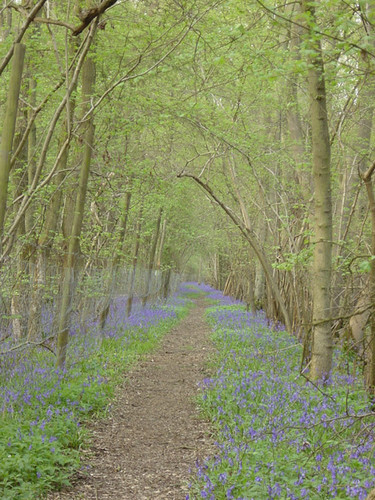History
A large wood in this area of the parish was mentioned in the 1068 Domesday Book, but by 1251 it had been split into two: Hayley Wood (40 acres) and Littlehound Wood (32 acres). Agriculture in the area declined after 1350 and the wooded area expanded; by 1650, Hayley Wood covered 120 acres and Littlehound 40. Around 1655, Littlehound was 'new stubbed' and disappeared under cultivation, although its outline can still be seen in the form of field boundaries. Hayley Wood was confiscated from the Bishop of Ely by Queen Elizabeth in 1579 and became privately owned.
The Varsity Line - a railway between Bedford and Cambridge - ran along the wood's northern edge between 1863-1969. Now disused, its bed has created different habitats and brought plant species. Hayley Wood was purchased in 1962 by what was then the Cambridgeshire and Isle of Ely Naturalists' Trust (now the Wildlife Trust for Bedfordshire, Cambridgeshire, Northamptonshire and Peterborough).
This ancient woodland is a treasure trove of spring flowers, traditional management practices and archaeological clues to times past. As well as the usual flora, such as bluebell, wood anemone and dog’s mercury, Hayley Wood is host to hundreds of species of fungi, and thousands of insects and birds. Its chequered history is laid out for all to see, if you know how to look.

Geography
Hayley Wood lies in the south-east corner of the civil parish of Little Gransden in Cambridgeshire, 10 miles (17 km) south-west of Cambridge and 45 miles (73 km) north of London.[5] The clay soil is heavy, leading to waterlogged conditions[6] on the flat hilltop.
As you walk up Hayley Lane, the hedge on your left is at least 800 years old and in the winter groans with berries that sustain fieldfares and redwings. As you pass the cottage, you cross the bed of the old Cambridge to Bedfordshire railway line. The tracks are long gone but the telegraph poles give a clue to the industrial past and many of the plants which thrive here today were carried here as seed in the wake of speeding trains.
Flora and fauna
The structure of Hayley Wood is coppice-with-standards of Field Maple, Ash, Hazel and Hawthorn species, with a canopy of Pendunculate Oak and small areas of Small-leaved Elm. Most of the oak trees date from between 1780-1840, older than most woodland oaks.
Management
There are many ancient coppice stools in the wood; coppicing was practiced from at least the 13th Century until the early 20th Century, with a revival from 1964. Traditional management practices are still used in the woodland, including coppicing of an acre of Hazel per year, and hedgelaying to encourage growth and retain structure. Intervention is kept to a minimum so that the wood can return to its original state and dead wood is left as it is an excellent habitat for liverworts and woodpeckers.

The rides and glades are mown to keep nutrient levels down. Most of the wood is surrounded by a fence, erected in 1972,to exclude deer, which has had the effect of reversing the decline in Hayley Wood's famous Oxlip population.
The soil favours Oxlip and Meadowsweet - the wood is described as 'one of the largest Oxlip woods on the chalky Boulder Clay in Britain'. Bluebell and Yellow Archangel grow in drier parts. Plants typical of ancient woodland, including Wood Anemone, Dog's Mercury and Early Purple Orchid, grow; Bird's-nest Orchid and Pale Sedge can also be found. The wood's plantlife is the reason for its designation as a Site of Special Scientific Interest; it was included in Derek Ratcliffe's A Nature Conservation Review, a survey of the country's most important wildlife sites.
In the wood itself you cannot fail to notice the fence, erected by the Wildlife Trust to protect most of the wood from the ravages of deer browsing. Although not in keeping with the landscape, it has reversed twenty years of decline in the oxlip population for which the wood is so famous. The area you first enter is young oak woodland, grown up since 1920 on a ridged arable field, then as you pass over the bank and ditch which mark the original wood boundary, you enter the ancient wood.

The main ride is a flower-filled corridor between 14 coppice plots, it shows the gradual progress from freshly harvested crop, through lush spring flowers to shady grove. At the end of the plots is the roundabout, the historical turning point for teams of heavy horses when extracting timber, now the site of an information hut where you can explore more of the history of the site. From here you can see some of the wilder parts of the wood, where coppicing is long abandoned and the undergrowth is thicker.






